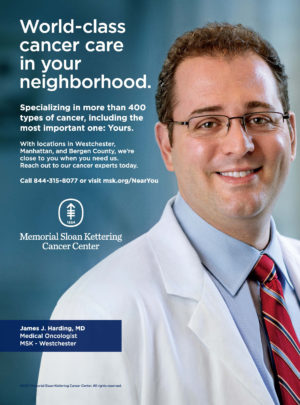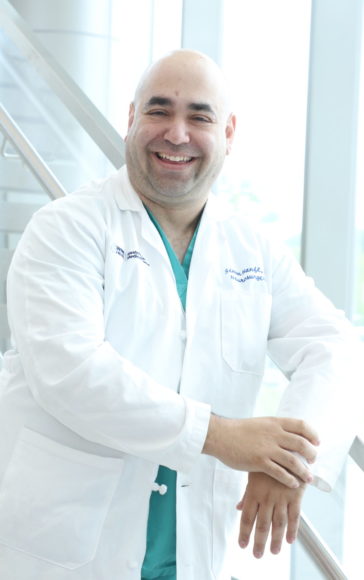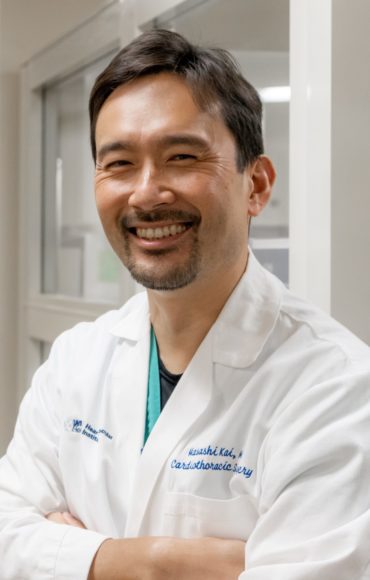They are two of the most challenging types of procedures — heart transplant and brain surgery. But two recent developments are making the processes smoother for doctors and patients alike. TransMedics’ “Heart-in-a-Box” ultimately allows for a greater pool of viable hearts. Gamma Tile is an implanted, time-release form of radiation that can mitigate the stress of postoperative therapy for those with brain cancer.
In the Hudson Valley, both can be found only at Westchester Medical Center in Valhalla. (westchestermedicalcenter.org).
Recently, WAG spoke with Simon Hanft, M.D., the center’s chief of neurosurgical oncology, and Masashi Kai, M.D., its surgical director of heart transplantation and mechanical circulatory support, about these exciting innovations in their respective fields:
Communicating the brain
The National Brain Tumor Association estimates that more than 84,000 people in the United States will receive a primary brain tumor diagnosis this year.
“It’s not the most common form of cancer, but it is among the deadliest,” says Simon Hanft, M.D., chief of neurosurgical oncology at Westchester Medical Center in Valhalla.
As with other forms of cancer, radiation can play a key though challenging role. But how best to deliver that radiation to maximize effectiveness while minimizing patient wear-and-tear? That’s where Gamma Tile, a kind of
time-release radiation therapy that only recently became available in the Hudson Valley via Westchester Medical Center, comes into play.
But first, a little background on brain cancer from Hanft, who’s terrific at breaking down the terrifying and the complex as you would expect from a neurosurgeon who holds a master’s degree in English from England’s University of Cambridge.
“I would divide brain cancer into two types of cancer. The first includes tumors rising from the brain.” Under this umbrella, you have glioma, a type of tumor that occurs in the brain and spinal cord, and glioblastoma, the most aggressive of cancers that begin in the brain. There are around 15,000 new cases of glioblastoma a year, he says. The late senators Edward M. Kennedy and John McCain died of glioblastoma, as did President Joe Biden’s older son, Beau.
The second type of brain cancer is metastatic, in which the disease travels from another place, like the breast or the lung, to the brain. The controversial cycling star Lance Armstrong developed brain cancer after suffering from testicular cancer, which Hanft calls a “very uncommon” progression.
When you remove a brain tumor, Hanft says, you radiate the area. Even so, cancerous cells may linger and lurk in the cavity.
“What the Gamma Tile does is take care of the radiation in one fell swoop.”
Gamma Tile is a trademarked, FDA-approved radionuclide brachytherapy, which involves the implantation of radioactive seeds. Using Gamma Tile, Hanft embeds several postage-size implants into the patient’s brain after removing the tumor.
“These implants contain radioactive seeds that will slowly emit radiation to the surrounding area.”
More than 90 percent will be emitted over the course of a month, with the rest following. The implants are then absorbed by the body, thereby forgoing any need for removal.
“The reason it has gained traction is that you don’t have to bring the patient back and forth for radiation,” Hanft says. “It’s a nice alternative to repeat radiation that often has fewer side effects.”
Though often used for metastatic and recurring brain cancers, Gamma Tile is also being used and studied for its effectiveness in fighting glioblastomas.
“The early data is promising,” Hanft says. And that’s good news, because the postoperative radiation treatment for glioblastomas is, he adds, “onerous” — six weeks, five days a week, 30 sessions.
While Gamma Tile is “specifically designed for the brain,” Hanft says he can see its potential for other cancers. It is one of several advances in neuroscience being used at Westchester Medical Center. Others include:
- a new software platform that provides detailed views of the brain;
- artificial intelligence for advanced stroke detection;
- three-dimensional, high-definition operating microscopes;
- flow diverter stents used in the care of cerebral aneurysms;
- surgical robots for complex surgical interventions;
- responsive neurostimulation therapy;
- the Hudson Valley’s only hybrid-operating room, where surgeons and interventionists can perform procedures using advanced imaging equipment.
Among the more fascinating innovations is a liquid compound that makes brain tumors glow for easier identification. A few hours before surgery, Hanft says, the patient drinks the compound, called 5-ALA or Gleolan, which is absorbed by the tumor and turns up bright pink on the filtered operating-room microscopes.
He also uses Omniscient Neurotechnology software “to detail the critical networks in the brain and their anatomical relationship to the tumor” during an awake craniotomy, which in the Hudson Valley is done only at Westchester Medical Center. Hanft will map the brain’s surface and remove the tumor, while a speech pathologist checks on the conscious patient’s language functions. (In most people, these functions reside primarily in the brain’s left hemisphere.) During the awake portion of the surgery, the patient feels nothing as the brain lacks pain receptors.
Language is important to Hanft. Growing up on Long Island, he was interested in science but went on to major in English at Yale University, then garner a master’s in English at Cambridge. But Hanft was also premed. There was never any doubt as to which interest would win out as he earned his medical degree at Stanford University School of Medicine. While there, he became attracted to neurosurgery, which he saw as a challenging, versatile field that would never become rote or boring.
It’s practically a cliché that surgeons have good hands or good hand-eye coordination. Yet more important, Hanft says, are critical thinking skills — judgment and decision-making.
“You have to put yourself in the position of the patient,” he adds, “and very few surgeons do that.”
Still, it’s something Hanft tries to impart to other doctors, as “teaching is a big part of what we do at the hospital,” as well as to his patients.
“You’re like a coach,” he says. “The best thing you can do is give people calm and hope.”

An easier way to access hearts for transplants
A “Heart-in-a-Box:” Sounds like the perfect Valentine’s Day gift, no?
It is a gift, all right, but one of a different, life-saving kind that can ease the process and increase the number of successful heart transplants. And Westchester Medical Center in Valhalla — one of seven heart transplant centers in New York state — is the first to make use of it.
Pioneered by South African surgeon Christian Bernard in 1967, using techniques developed by American surgeons Norman Shumway and Richard Lower, heart transplantation is “still very specialized” in the United States, says Masashi Kai, M.D. surgical director of heart transplantation and mechanical circulatory support at Westchester Medical Center in Valhalla, Kai leads its use of the “Heart-in-a-Box” in a state that has one of the lowest organ donation rates. Indeed, according to Syracuse.com, only about 22 percent of residents are registered as donors, compared with a national average of 45 percent.
Meanwhile, there are some 3,535 people on the waiting list for a heart transplant in the United States — 325 of whom are listed at transplant hospitals in New York state, according to the United Network of Organ Sharing (UNOS), a Richmond, Virginia-based nonprofit that serves as the nation’s transplant system under contract with the federal government. Last year, 3,658 heart transplants were performed, with 250 of those done at transplant hospitals in New York. But 239 people died on the waiting list for a heart that didn’t come in time, while another 270 were removed, because they were too sick to transplant.
That’s what makes the TransMedics Organ Care System so crucial, Kai says. Traditionally, he says, “When the heart is retrieved, you put it in ice in a cooler. The heart is not beating until transplantation….That has to be done within four hours. If it’s past four hours, the heart function will be decreased.”
That limits the number of hearts and the locations from which they can be obtained, Kai adds, with the organs having come to the medical center from no farther south than North Carolina and no farther west than Ohio.
“The second limitation,” he says, “is the actual heart function. You don’t know until you transplant it…if it’s not perfect.”
With TransMedics’ “Heart-in-a-Box,” the heart is placed in a warm container with circulating blood from the donor and oxygen — simulating the conditions of the body. Doctors know right away if this beating heart is functioning normally. And because the heart is functioning all the while, it can be transported from farther distances, enlarging the area a hospital can draw from.
Westchester Medical Center has done three heart transplants this year using the “Heart-in-a-Box,” with the first taking place in April and involving a 73-year-old Albany man. All of these patients are home and doing well, Kai says.
The first year is critical, he adds. After that, the survival rate increases, although heart transplant recipients have to take antirejection medications for the rest of their lives. Patients can, he adds, be vaccinated against Covid-19.
“This is not going to completely replace the traditional method,” he says of the “Heart-in-a-Box.” “But in the future, we can use it to increase the donor pool.”
Born and raised in Japan, Kai became interested in physiology as a teenager. He received his M.D. from Tokyo Jikei University in Japan and did his residency training in cardiovascular surgery at Kyoto University. Moving to the United States in 2007, Kai completed a fellowship in cardiothoracic surgery at New York University Medical Center (now NYU Langone Health) and an advanced fellowship at New York-Presbyterian Hospital/Columbia University Irving Medical Center, where he had special training in heart transplantation and mechanical circulatory support device (LVAD, ECMO) implantation. He joined cardiothoracic surgery at Westchester Medical Center in 2011.
Kai is also a researcher, investigating innovative surgical treatments for heart failure in multiple clinical trials. His work has been published in numerous peer-reviewed journals.
“I always wanted to do dynamic stuff,” he says. “The heart is very dynamic.”






